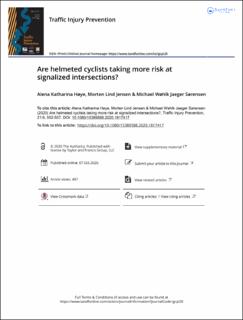| dc.contributor.author | Høye, Alena | |
| dc.contributor.author | Jensen, Morten Lind | |
| dc.contributor.author | Sørensen, Michael Wøhlk Jaeger | |
| dc.coverage.spatial | Denmark | en_US |
| dc.date.accessioned | 2021-07-16T12:01:34Z | |
| dc.date.available | 2021-07-16T12:01:34Z | |
| dc.date.created | 2020-10-09T11:48:23Z | |
| dc.date.issued | 2020-10-07 | |
| dc.identifier.citation | Traffic Injury Prevention. 2020, 21 (8), 552-557. | en_US |
| dc.identifier.issn | 1538-9588 | |
| dc.identifier.uri | https://hdl.handle.net/11250/2764684 | |
| dc.description.abstract | Objective The aim of the present study was to investigate the relationship between bicycle helmet use and safety behavior at signalized intersections. Two hypotheses were investigated: The first states that bicycle helmet use leads to risker behavior because of the increased sense of protection (risk compensation), the other states that helmeted cyclists have a general inclination toward safer behavior (safety package) and that helmet use is one of several behaviors for improving safety. Method Based on video recordings of 1031 cyclists at 12 signalized intersections in Denmark, two indicators of risky behavior were compared between helmeted and unhelmeted cyclists: Speed and time after the onset of yellow at which the cyclists crossed the stop line. Linear regression models were developed with gender, type of bicycle, and intersection characteristics as predictor variables, in addition to helmet use. Results Helmeted and unhelmeted cyclists do not differ in how many seconds after the onset of yellow they cross the stopping line. This is consistent with the absence of both risk compensation and safety package, alternatively with a general inclination of helmeted cyclists toward safer behavior which is about offset by risk compensation. Helmeted cyclists had higher speed on average, which indicates that risk compensation may occur. However, the higher speed may also be due to the generally better fitness of helmeted cyclists which is likely to result from larger cycling volumes. Moreover, the effect of helmet use on speed may be overestimated because of a lack of control for potential confounding variables. The results show further that, regardless of helmet use, before-red (lights on a separate bicycle signal shift to red before the main signal) is related to later crossings of the stop lane after the onset of yellow and that cyclists stop earlier on average at intersections with right-turn signals. Conclusions The results do not provide support for the position that promoting or mandating bicycle helmet use will have adverse safety effects because of more risky behavior among helmeted cyclists. | en_US |
| dc.language.iso | eng | en_US |
| dc.publisher | Taylor and Francis | en_US |
| dc.rights | Attribution-NonCommercial-NoDerivatives 4.0 Internasjonal | * |
| dc.rights.uri | http://creativecommons.org/licenses/by-nc-nd/4.0/deed.no | * |
| dc.title | Are helmeted cyclists taking more risk at signalized intersections? | en_US |
| dc.type | Peer reviewed | en_US |
| dc.type | Journal article | en_US |
| dc.rights.holder | © 2020 The Author(s). Published with license by Taylor and Francis Group, LLC | en_US |
| dc.description.version | publishedVersion | en_US |
| cristin.ispublished | true | |
| cristin.fulltext | original | |
| cristin.qualitycode | 1 | |
| dc.identifier.doi | 10.1080/15389588.2020.1817417 | |
| dc.identifier.cristin | 1838441 | |
| dc.source.journal | Traffic Injury Prevention | en_US |
| dc.source.volume | 21 | en_US |
| dc.source.issue | 8 | en_US |
| dc.source.pagenumber | 552-557 | en_US |

